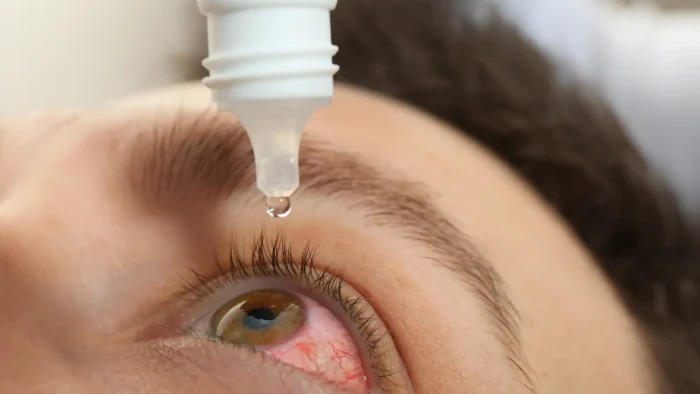Business Hours: Monday - Friday: 9 AM - 6 PM EST

Eylea FDA Approval – Is Eylea FDA-Approved for Retinal Diseases?
David Fuller
Last Updated On: February 12, 2025
Retinal diseases like age-related macular degeneration (AMD) and diabetic retinopathy are among the leading causes of vision loss worldwide. In the United States, approximately 8 million people live with a vision disability, and the prevalence of AMD increases significantly with age—affecting up to 60% of individuals aged 95 to 99 years compared to just 13% of those aged 65 to 69.
To address these conditions, anti-VEGF therapies have been developed to prevent abnormal blood vessel growth in the retina, a key factor in disease progression. Among these treatments, Eylea (aflibercept) stands out as a widely used and effective option for managing several retinal diseases.
In this article, we will explore Eylea’s FDA approval status, its approved indications, and the clinical evidence supporting its use in treating retinal conditions.
Key Takeaways
- Eylea was first approved by the FDA in 2011 for the treatment of wet age-related macular degeneration (AMD) and has since expanded to include diabetic macular edema (DME), retinal vein occlusion (RVO), and myopic choroidal neovascularization (mCNV).
- Eylea has been proven effective in reducing abnormal blood vessel growth and fluid leakage in the retina, supported by robust clinical studies, including the VIEW 1 and VIEW 2 trials.
- Eylea stabilizes and may improve vision. Compared to other treatments, it requires fewer frequent injections and has a well-established safety profile.
- Eylea underwent a rigorous multi-stage FDA approval process, ensuring its safety and effectiveness before market availability.
- Common side effects are generally mild, including temporary eye irritation or redness, while serious complications are rare but require immediate medical care.
About: Med Supply Solutions has been operating since 2016 and is known as one of the industry’s top and trusted suppliers of cosmetic and viscosupplementation products. Contact our sales department for more information about buying Eylea online.

Eylea’s FDA Approval Journey

Eylea (aflibercept) received its first FDA approval in 2011 for treating wet age-related macular degeneration (AMD) after clinical trials demonstrated its effectiveness in reducing abnormal blood vessel growth and fluid leakage in the retina. Since then, its indications have expanded to include diabetic macular edema (DME), retinal vein occlusion (RVO), and myopic choroidal neovascularization (mCNV).
Robust clinical studies, including the VIEW 1 and VIEW 2 trials for wet AMD, supported the FDA approval of Eylea. These trials showed that Eylea was as effective as ranibizumab (Lucentis) in maintaining vision while requiring fewer injections. Additional studies, such as the VIVID and VISTA trials, further confirmed Eylea’s benefits in treating DME and RVO, reinforcing its role as a leading treatment for retinal diseases.
Eylea’s Indications and Patient Outcomes

Eylea is FDA-approved for treating multiple retinal diseases, making it a versatile and effective option for vision-threatening conditions. Its approved indications include:
- Wet Age-Related Macular Degeneration (AMD): Prevents abnormal blood vessel growth and reduces fluid buildup in the retina.
- Diabetic Macular Edema (DME): Helps control retinal swelling, leading to improved vision.
- Retinal Vein Occlusion (RVO): Treats macular edema caused by blocked retinal veins.
- Myopic Choroidal Neovascularization (mCNV): Slows vision loss in individuals with severe nearsightedness.
Clinical Benefits of Eylea
Eylea has been shown to:
- Stabilize and, in some cases, improve vision.
- Reduce the need for frequent injections compared to other anti-VEGF therapies.
- Lower the risk of disease progression in retinal conditions.
- Provide long-term benefits with a well-established safety profile.
The Regulatory Process for FDA Approval
The FDA approved Eylea after rigorous testing to ensure its safety and effectiveness before it became widely available. This multi-stage process confirmed its role as a reliable treatment for retinal diseases.
- Preclinical studies involved laboratory research and animal testing to evaluate Eylea’s safety, helping determine if it could proceed to human trials while minimizing risks.
- Phase 1 trials assessed the drug’s dosage and potential side effects in a small group of patients, ensuring it was well-tolerated before advancing to broader studies.
- Phase 2 trials focused on Eylea’s efficacy and optimal dosing, providing early evidence of its ability to treat retinal conditions like wet AMD and diabetic macular edema.
- Phase 3 trials included large-scale research with thousands of patients, such as the VIEW 1 and VIEW 2 studies, which confirmed Eylea’s effectiveness in improving vision and reducing disease progression.
The FDA review process required submitting extensive clinical data, undergoing expert evaluations, and implementing post-approval safety monitoring. After meeting all regulatory standards, Eylea became a first-line treatment for retinal diseases.
When comparing Eylea injection vs Avastin, Eylea holds a distinct advantage as an FDA-approved treatment, whereas Avastin is used off-label for retinal conditions. FDA approval ensures standardized dosing, proven efficacy, and a well-documented safety profile, making Eylea a preferred choice for many patients.
Conclusion
Eylea’s FDA approval highlights its effectiveness in managing retinal diseases such as wet AMD, DME, and RVO. Backed by extensive clinical research, it remains a preferred choice for both patients and ophthalmologists. Compared to alternatives like Avastin, Eylea offers the advantage of fewer injections and longer-lasting results.
Consulting a retina specialist is essential to determine the most suitable treatment approach based on individual needs and disease progression.
FAQs
1. When was Eylea first FDA-approved?
Eylea was first approved by the FDA in 2011 for treating wet age-related macular degeneration (AMD). Since then, its indications have expanded to include DME, RVO, and myopic choroidal neovascularization.
2. How does Eylea compare to Avastin?
Eylea and Avastin both target VEGF to reduce abnormal blood vessel growth. However, Eylea requires fewer injections and is explicitly FDA-approved for retinal diseases, while Avastin is used off-label and requires compounding.
3. Does insurance cover Eylea treatments?
Most insurance plans, including Medicare, cover Eylea for FDA-approved indications. However, coverage may vary; patients should verify with their provider for specific details.
4. What are the common side effects of Eylea?
Mild side effects include temporary eye irritation, redness, or discomfort at the injection site. Serious complications, such as intraocular inflammation or infection, are rare but require immediate medical attention.
References
National Eye Institute. (2014). Eye Disease Statistics. Retrieved February 6, 2025, from https://www.nei.nih.gov/sites/default/files/2019-04/NEI_Eye_Disease_Statistics_Factsheet_2014_V10.pdfEylea (aflibercept) FDA Approval History. Drugs.com. https://www.drugs.com/history/eylea.html
Products
Cart
Log In
Newsletter
Subscribe for exclusive offers and updates on new arrivals
Share feedback at:
Working Hours
Monday to Friday: 9 AM to 6 PM EST
The Most Popular Brands
Med Supply Solutions
Support
Copyright 2025. Med Supply Solutions